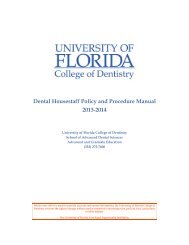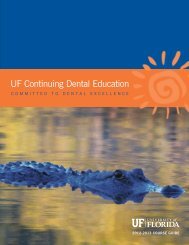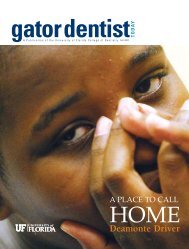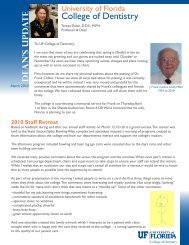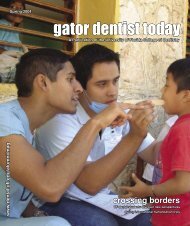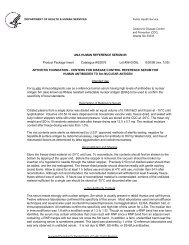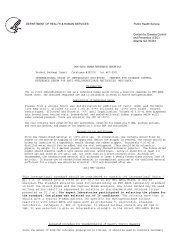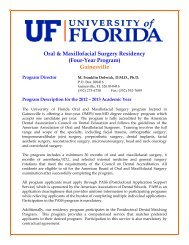Centromere pattern FANA
Centromere pattern FANA
Centromere pattern FANA
You also want an ePaper? Increase the reach of your titles
YUMPU automatically turns print PDFs into web optimized ePapers that Google loves.
DEPARTMENT OF HEALTH & HUMAN SERVICES<br />
Public Health Service<br />
Centers for Disease Control<br />
and Prevention (CDC)<br />
Atlanta GA 30333<br />
ANA HUMAN REFERENCE SERUM #8<br />
Product Package Insert Catalogue #IS2134 Lot #84-0026 7/7/84 (rev. 1/05)<br />
ARTHRITIS FOUNDATION - CENTERS FOR DISEASE CONTROL REFERENCE SERUM FOR FLUORESCENT<br />
ANTINUCLEAR ANTIBODY (CENTROMERE PATTERN)<br />
Intended Use<br />
For in vitro immunodiagnostic use as a reference human serum giving a centromere <strong>pattern</strong> in the<br />
fluorescent antinuclear antibody (<strong>FANA</strong>) test to be used to confirm specificity of local standards.<br />
Description of Reference Serum<br />
Citrated plasma from a single donor was made 0.01 M CaCl 2 and 0.013 M epsilon-amino-n-caproic acid,<br />
allowed to clot at 4°C overnight, centrifuged, and frozen at -70°C until lyophilization. Volumes of<br />
0.50 ml were dispensed into borosilicate vaccine vials, freeze-dried, and sealed with butyl rubber<br />
stoppers while still under reduced pressure. Vials are stored at the CDC at -20°C. The mean dry<br />
weight and SD of material in 10 randomly selected vials after freeze-drying was 6.5 ± 0.8 mg.<br />
Thermal stability studies of the freeze-dried material indicate an extrapolated half-life of >900<br />
years when stored at -20°C.<br />
The vial contents were sterile as determined by U.S.P. approved methods of sterility testing,<br />
negative for hepatitis-B surface antigen by radioimmunoassay, negative for antibody to HIV by Western<br />
blot, and free of rheumatoid factors as determined by latex agglutination and radioimmundassay.<br />
Reeonstitution and Storage<br />
Store the freeze-dried material at -20°C until use. To reconstitute, the contents should first be<br />
shaken to the bottom by tapping of the upper end. Before the stopper is removed, the vacuum should be<br />
broken by insertion of a hypodermic needle through the rubber stopper. Precisely 0.50 ml of distilled<br />
water should then be added, and the vial restoppered. The freeze-dried powder should dissolve<br />
readily with gentle swirling (avoid foam). Allow to stand for at least 1 h before use and store at<br />
4°C until use, not later than 24 h after reconstitution. Although not recommended, the reconstituted<br />
material will withstand at least 8 weekly freeze-thaws without loss of activity. If future use of<br />
reconstituted material is contemplated, portions of the undiluted material sufficient for a single<br />
use should be stored at -70°C and discarded after use.<br />
<strong>FANA</strong> Content<br />
This serum gives a centromere <strong>FANA</strong> <strong>pattern</strong>. Nine reference laboratories using fluorescein-labelled<br />
polyvalent (all Ig classes) -human Ig reagents and a human cell line substrate containing mitotic<br />
figures (Hep-2) obtained a median titer of 1:640 with a modified range of 1:320 to 1:1024. Using the<br />
W.H.O. fluorescein-labelled -human immunoglobulin standard at the recommended dilution (1:20), this<br />
serum had a titer of 1:1024 using Hep-2 cells as substrate. Using immunoglobulin class-specific<br />
reagents, titers with Hep-2 cells as substrate were: IgG, 1:1024; IgM,
Suggested procedure for Standardization of Quality Control Reagents<br />
The sensitivity of the <strong>FANA</strong> test is influenced by the choice of tissue substrate, the staining procedure,<br />
the fluorescein conjugate, the microscope, and the observer. Changes in any of these in the day to day<br />
performance of the test may be detected by including a stable positive control (and negative control)<br />
serum in each run.<br />
Since the amount of AF/CDC reference preparation is limited, it should be used to calibrate secondary<br />
standards which can be run each day along with other samples being analyzed. The validity of any<br />
secondary standard depends on its having the same specificity as the primary AF/CDC standard (anti-nDNA,<br />
anti-Sm, etc.). The specificity can be determined by EIA, double immunodiffusion (anti-nRNP, anti-Sm,<br />
anti-SSB/La) or by analysis for anti-nDNA (Farr assay, millipore filter assay, Crithidia test).<br />
To calibrate a secondary standard (i.e., a positive control to be included in subsequent routine test<br />
runs):<br />
1. Reconstitute ampule as described above.<br />
2. Prepare doubling dilutions of the AF-CDC reference serum and the secondary standard from 1:10<br />
to 1:1280.<br />
3. Carry out the routine test procedure on the dilutions.<br />
4. Determine the nuclear fluorescence end point showing minimal recognizable staining.<br />
5. Relative potency = reciprocal of end point dilution of secondary standard<br />
reciprocal of end point dilution of AF-CDC serum<br />
If the secondary standard is stable, the relative potency obtained should not change. Any changes in<br />
day to day results with the secondary standard are more likely due to changes in test performance.<br />
Generally, in the day to day performance of the test, serial dilutions of the secondary standard<br />
are run. A single dilution, unless it is run at or near its end point, may not reveal major<br />
changes in test performances.<br />
In selecting a secondary standard, a serum (available in plentiful supply) containing anti-nuclear<br />
antibody of similar specificity and resulting in a similar staining <strong>pattern</strong> should be obtained. The<br />
titer need not be similar. This should be stored undiluted in aliquots sufficient for one run (store at<br />
-20°C or below).<br />
These reference sera can also be used to determine the most suitable or sensitive method, kit,<br />
or reagents, to compare one's results with that of the laboratories which initially evaluated<br />
the reference serum, and as a common reference for interlaboratory comparability.<br />
Consensus evaluation results on the AF-CDC preparation are given above (<strong>FANA</strong> content) for comparison<br />
to your own results.<br />
Caution<br />
This serum was found to be negative for hepatitis-B surface antigen, hepatitis C and HIV antibody. Since<br />
no test method can offer complete assurance that these or other infectious agents are absent, this serum<br />
should be handled at the Biosafety Level 2 as recommended for any potentially infectious human serum or<br />
blood specimen (Centers for Disease Control, National Institutes of Health. Biosafety in Microbiological<br />
and Biomedical Laboratories, 1st Edition, 1984, 11-13).<br />
Supplementary Information<br />
The reference for a general description of the AF-CDC reference sera is: Tan EM, Fritzler MJ, McDougal<br />
JS, McDuffie FC, Nakamura RM, Reichlin M, Reimer CB, Sharp GC, Schur PH, Wilson MR: Reference Sera for<br />
Antinuclear Antibodies. Arthritis and Rheumatism 25:1003-1005, 1982. Detailed descriptions of the<br />
preparation, analysis, reagents, antigens, substrates, and individual reference laboratory results are in<br />
a supplementary publication available upon request:<br />
AF-CDC ANA Reference Lab<br />
Immunology Branch, 17-3040, A25<br />
Centers for Disease Control and Prevention (CDC)<br />
Atlanta, GA 30333



